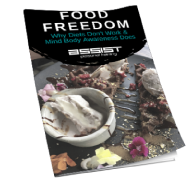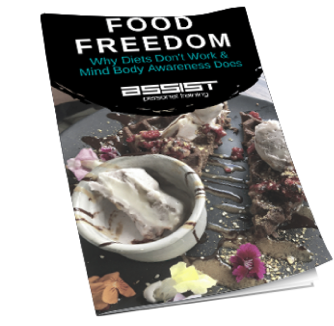If you’ve ever found yourself confused about what to eat — plant based, keto, paleo, vegan, high protein, low fat — you’re not alone. Every few months a new “miracle” diet trend sweeps through social media and documentaries promising to be the answer. It’s no wonder so many people end up overwhelmed, bouncing between extremes, and feeling more disconnected from their body than ever.
I’ve been helping people transform their health and body composition since 2009. I’ve studied nutritional biochemistry, used a modality known internationally as Nutritional Reflex Testing to muscle test hundreds of clients, and worked with bodies in real life, not just theory. And after all these years, my answer to the “best diet” question is still:
It depends. Because there is a deeper template beneath it all.
The human template.
Every body is unique, biochemically, ancestrally, and energetically. Even identical twins can differ in quadrillions of biochemical processes. So it makes sense why there is no one diet that is best for all. However, underneath these differences lies a simple, timeless truth:
Real food is hunted, gathered, caught, or grown. Everything else is a product.
The closer your food is to its natural, unprocessed, life filled state, the more your body recognises it as fuel rather than foreign. Think of it less as a “diet” and more as aligning your body with life force.
The optimal diet for a human being is one that is:
- Electrically alive (fresh, water rich, real)
- Easy to digest (supports, not stresses, your system)
- In tune with light cycles (eating with the sun, not against it)
- Supportive of your nervous system rather than hijacking it
Building a High Frequency, Low Interference Plate
Raw fruits, especially berries, citrus, and grapes, act as nature’s cellular cleaners. They’re electrically alive, rich in structured water, and packed with bioavailable nutrients that hydrate, energise, and help the body release stored density. Fruits work like gentle internal cleansers, supporting lymphatic flow and awakening cellular vitality in a way that feels light yet deeply restorative.
Leafy greens, sprouted seeds, microgreens, and lightly steamed vegetables then provide the minerals, structure, and grounding your body needs. They stabilise the nervous system, repair tissues, and bring balance after cleansing. Think of them as daily nourishment for your cells, replenishing what modern processed diets often deplete.
Cravings often point to deeper emotional needs. They reveal where trauma is seeking safety. When you begin feeding your nervous system rather than your wounds, everything starts to shift.
Herbs, roots, and spices are more than flavour enhancers, they’re concentrated plant medicines. Many contain potent phytonutrients, antioxidants, and compounds that support detoxification, circulation, and immune resilience. Warming herbs like ginger, turmeric, and cinnamon stimulate digestion and blood flow. Bitter herbs such as dandelion and gentian activate liver function and bile production. Aromatic herbs like basil, rosemary, thyme, and coriander help clear stagnation and microbial imbalances, while adaptogens such as ashwagandha and holy basil regulate stress responses and support adrenal health. Using herbs and spices daily transforms meals into therapeutic rituals, blending ancient healing wisdom with modern nourishment.
To complete the plate, include supportive additions that help your body thrive: clean fats like avocado, coconut, olive oil, nuts, and sea vegetables to stabilise energy and strengthen cellular membranes; mineral-rich salts such as Celtic or Himalayan to supply essential trace minerals; structured water, nourishing soups, and broths (if not vegan) to restore hydration at a deep cellular level; and magnesium rich foods like leafy greens, bananas, and cacao to calm the nervous system and support hundreds of enzymatic reactions.
Digestion and Sunlight: Why Timing Matters
Your body evolved over hundreds of thousands of years to function in alignment with natural light cycles, not arbitrary schedules. Sunlight acts as a cue for your circadian rhythm, which governs hormone release, metabolism, digestion, and energy levels. When your eating schedule is in harmony with natural light, digestion and nutrient absorption are more efficient, and your body’s energy flows optimally.
Morning → Gentle Reset or Protein Fat Fuel
Many people benefit from hydration and light, easily digestible foods like fruit in the morning, providing gentle cleansing, cellular hydration, and quick energy. Others thrive on a higher protein, higher fat meal first thing, which stabilises blood sugar and supports sustained energy. The key is tuning into how your body responds, rather than following a rigid “one size fits all” rule.
Midday → Main Grounding Meal
Around midday, your digestive system is generally strongest. This is an ideal window for your main, grounding meal, which might include proteins, healthy fats, and fibrous vegetables. Sunlight helps stimulate digestive enzymes and hormones, enhancing nutrient absorption and energy production. For some, this might be the heaviest meal of the day; for others, it may be more moderate, depending on their needs and metabolism.
Evening → Lighter Meals for Rest and Repair
As the sun sets, the body naturally shifts toward repair and restoration. Lighter meals such as soups, broths, or teas reduce digestive strain, support cellular repair, and prepare the nervous system for restorative sleep. Heavy late night meals can interfere with circadian rhythms, feed emotional cravings, and reduce quality rest by leaving the body working overtime when it should be resting.
There isn’t a single “best” meal timing for everyone. The ideal approach depends on your metabolism, ancestry, and current nervous system state. When it comes to health and wellbeing, what matters most is that you manage stress as best as you can, listen to your body’s cues and align your eating patterns with natural light cycles to support digestion, energy, and overall balance.
What to Reduce or Eliminate
If you want clarity, vitality, and emotional steadiness, these are the foods to watch out for:
- Processed sugars & refined wheat
- Industrial seed oils (canola, sunflower, soybean — inflammation bombs)
- Factory meats, pasteurised dairy, fluoridated water
- Lab made “energy drinks” and synthetic vitamin waters
These mimic energy. They make you feel full but starve your cells of real life force.
Intention + Energetic Structure
Here’s something often overlooked: your words and energy code your food.
From the energy work and muscle testing I do, I have seen first hand the power of words spoken over the body.
Dr Emoto is very well known for his original work showcasing how words spoken over water are able to code the water with an energetic frequency. Fresh living foods can be treated exactly the same. Speaking over your food, whether you want to pray or show gratitude, not as a ritual, but to clear interference and realign its structure to life is a good practice. Words carry frequency. Water holds memory. Your voice can restructure the molecular field of what you’re about to absorb.
Try this simple practice:
Pour love over your food as you prepare and cook. Before eating, take a breath, relax your body and take a moment to appreciate the food on your plate.
To Eat Meat Or Not
Some people thrive on vegan or vegetarian diets because their bodies are ready for light, plant focused nutrition. These individuals typically have:
- A stable nervous system that can process high vibration, low density foods
- Strong digestion, including healthy stomach acid and enzymes
- A gut free from chronic trauma or inflammation
- Ancestral lineages adapted to light based, plant focused diets (eg. tropical or yogic cultures)
Others may struggle on vegan diets because their systems require more grounding and density to function optimally. These individuals may:
- Experience blood sugar instability or low mineral stores
- Be “over cleansing” without incorporating grounding foods, leaving the nervous system and cells under supported
- Carry gut trauma from antibiotics, medications, or years of processed foods
- Come from ancestries adapted to denser, animal based diets or cold climates (eg. Nordic, Mongolian, Inuit)
It’s not about labels or morality, it’s about alignment. The diet that supports your body’s energy, digestion, and nervous system is the diet that allows you to feel clear, calm, and alive. Grounding foods like healthy fats, mineral rich vegetables, broths, root vegetables, and protein can stabilise your system while still honouring a high frequency, whole food approach.
So, What’s the Best Diet?
The best diet is the one that helps you:
- Feel clear, calm, and awake after eating
- Hold more light without losing stability
- Bring your nervous system into peace, not spikes
- Build a resilient, vibrant, alive body
You don’t need to be raw vegan, keto, or paleo. You need to be aligned.
Your Next Step
If you’re ready to step out of confusion and into clarity, start by tuning in to how your food makes you feel, not what the label says. Your body will guide you home.
Want support? Come see me in person for an applied muscle testing session to work out what foods and way of eating is best for you or if you’ve got that sorted and struggle with compliance and consistency, contact us to see if The Mind + Body Lifestyle Overhaul online course is right for you. It provides you with all the tools and resources you need to not only understand what your body needs to look, feel and function at its best, but also how to create a lifestyle change that sticks. Reach out if you’d like more information about this online course.





